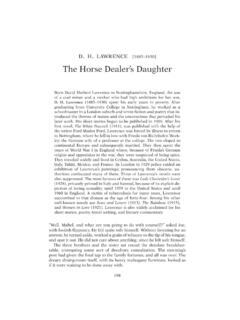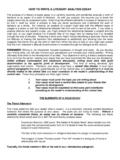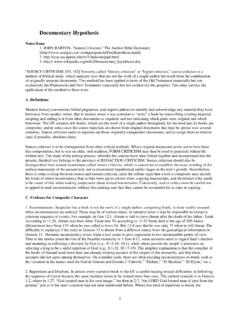Transcription of NARRATIVE ECONOMICS By Robert J. Shiller January 2017 ...
1 NARRATIVE ECONOMICS By Robert J. Shiller January 2017 COWLES FOUNDATION DISCUSSION PAPER NO. 2069 COWLES FOUNDATION FOR RESEARCH IN ECONOMICS YALE UNIVERSITY Box 208281 New Haven, Connecticut 06520-8281 NARRATIVE ECONOMICS Robert J. Shiller January , 2017 Presidential address delivered at the 129th annual meeting of the American economic Association, January 7, 2017, Chicago, IL. The author declares no relevant conflicts of interest. The author thanks participants in seminars at which earlier versions of this address were presented, at the Bank of England, at the Toulouse School of ECONOMICS /Toulouse Institute of Advanced Studies, and at the Yale University Department of ECONOMICS .
2 Special thanks go to George Akerlof, Bruno Biais, Jean-Fran ois Bonnefon, Michael Bordo, Donald Cox, Peter Dougherty, William Goetzmann, Dasol Kim, Rachel Kranton, Terry Loebs, Ramsay MacMullen, Peter Rousseau, Paul Seabright, Benjamin Shiller , Virginia Shiller , and Peter Temin. Research assistance was provided by Andrew Brod, Laurie Cameron Craighead and Nicholas Werle. 1 Robert J. Shiller January 2017 JEL No. E00, E03, E30, G02, N1 ABSTRACT This address considers the epidemiology of narratives relevant to economic fluctuations. The human brain has always been highly tuned towards narratives, whether factual or not, to justify ongoing actions, even such basic actions as spending and investing.
3 S tories motivate and connect activities to deeply felt values and needs. Narratives go viral and spread far, even worldwide, with economic impact. The 1920-21 Depression, the Great Depression of the 1930s, the so-called Great Recession of 2007-9 and the contentious political- economic situation of today, are considered as the results of the popular narratives of their respective times. Though these narratives are deeply human phenomena that are difficult to study in a scientific manner, quantitative analysis may help us gain a better understanding of these epidemics in the future. Robert J. Shiller Sterling Professor of ECONOMICS and Professor of Finance Cowles Foundation, Yale University 30 Hillhouse Avenue New Haven, CT 06511 and NBER 2 Introduction By NARRATIVE ECONOMICS I mean the study of the spread and dynamics of popular narratives, the stories , particularly those of human interest and emotion, and how these change through time, to understand economic fluctuations.
4 A recession, for example, is a time when many people have decided to spend less, to make do for now with that old furniture instead of buying new, or to postpone starting a new business, to postpone hiring new help in an existing business, or to express support for fiscally conservative government. They might make any of these decisions in reaction to the recession itself (that s feedback), but to understand why a recession even started, we need more than a theory of feedback. We have to consider the possibility that sometimes the dominant reason why a recession is severe is related to the prevalence and vividness of certain stories , not the purely economic feedback or multipliers that economists love to model.
5 The field of ECONOMICS should be expanded to include serious quantitative study of changing popular narratives. To my knowledge, there has been no controlled experiment to prove the importance of changing narratives in causing economic fluctuations. We cannot easily prove that any association between changing narratives and economic outcomes is not all reverse causality, from the outcomes to the narratives. But there have been true controlled experiments showing that people respond strongly to narratives, in the fields of marketing (Escalas 2007); journalism (Machill et al. 2007 ); education (McQuiggan et al. 2008); health interventions (Slater et al. 2003); and philanthropy (Weber et al.)
6 2006). My goal in this paper is to describe what we know about narratives and the penchant of the human mind to be engaged by them, to consider reasons to expect that narratives might well be thought of as important, largely exogenous shocks to the aggregate economy. This address extends some earlier work I have done with George Akerlof (Akerlof and Shiller , 2009, 2015) and some of my own earlier work going back decades ( Shiller 1984), but develops the analysis and captures a much broader relevant literature. Of course, almost nothing beyond spots on the sun is truly exogenous in ECONOMICS , but new narratives may be regarded often as causative innovations, since each NARRATIVE originates in the mind of a 3 single individual (or a collaboration among a few).
7 Joel Mokyr (2016) calls such an individual a cultural entrepreneur, and traces the concept back to David Hume (1742) who wrote that what depends on a few persons is, in great measure, to be ascribed to chance, or secret and unknown causes; what arises from a great number may often be accounted for by determinate and known causes. 1 I will present here some thoughts on these effects of a few persons and offer a class of mathematical models for some of these determinate and known causes of the path of narratives, quantifying the dynamics of narratives, and will consider how our understanding can be enhanced of major economic events: the Depression of 1920-21, the Great Depression of the 1930s, the Great Recession of 2007-2009, and our present time right after our NARRATIVE -filled 2016 presidential election.
8 I use the term NARRATIVE to mean a simple story or easily expressed explanation of events that many people want to bring up in conversation or on news or social media because it can be used to stimulate the concerns or emotions of others, and/or because it appears to advance self-interest. To be stimulating, it usually has some human interest either direct or implied. As I (and many others) use the term, a NARRATIVE is a gem for conversation, and may take the form of an extraordinary or heroic tale or even a joke. It is not generally a researched story, and may have glaring holes, as in urban legends. The form of the NARRATIVE varies through time and across tellings, but maintains a core contagious element, in the forms that are successful in spreading.
9 Why an element is contagious, when it may even go viral, may be hard to understand, unless we reflect carefully on the reason people like to spread the NARRATIVE . Mutations in narratives spring up randomly, just as in organisms in evolutionary biology, and when they are contagious, the mutated narratives generate seemingly unpredictable changes in the economy. Narratives can be based on varying degrees of truth. Wishful thinking may enhance contagion (Benabou 2013). The impact of non-factual narratives might be somewhat greater in today s world than in decades past, since established news media are in upheaval after the relatively recent advent of modern 1 Hume (1788) XIV p.
10 101. 4 information technology and social media. But in past decades we can also observe that narratives with no factual basis were widely disseminated and believed. For instance, until modern times, it was asserted that women were not capable of learning men s occupations (Goldin 2014). Similarly, it was argued that some racial or ethnic groups were not really capable of integrating into civilized society (Myrdal, 1974). How people could believe these views in the past seems hard to imagine today because we are no longer immersed in their narratives. Disturbingly, the Oxford Dictionary in 2016 gave post-truth as international word of the year.






